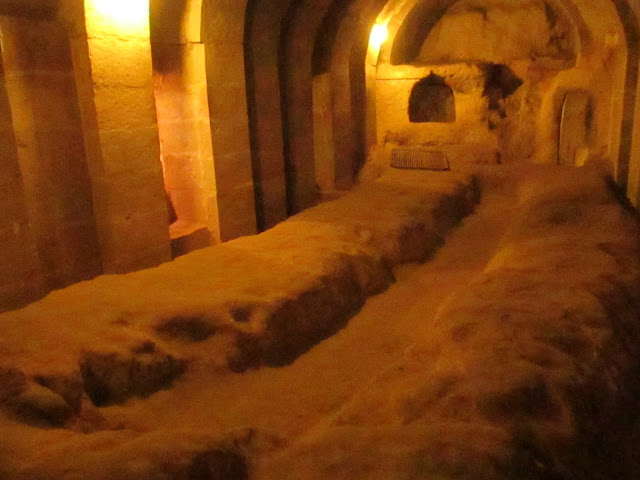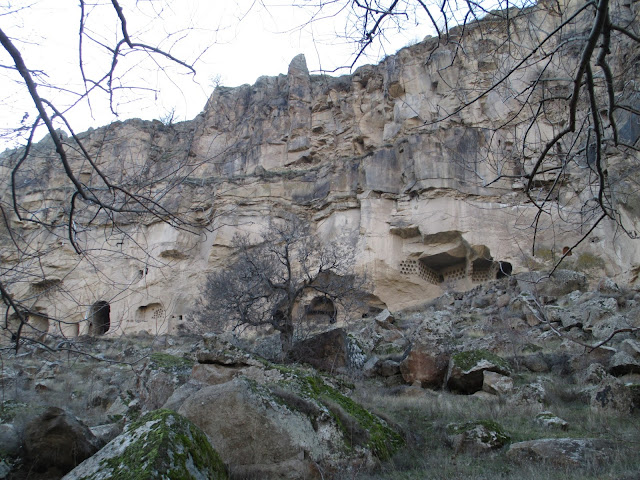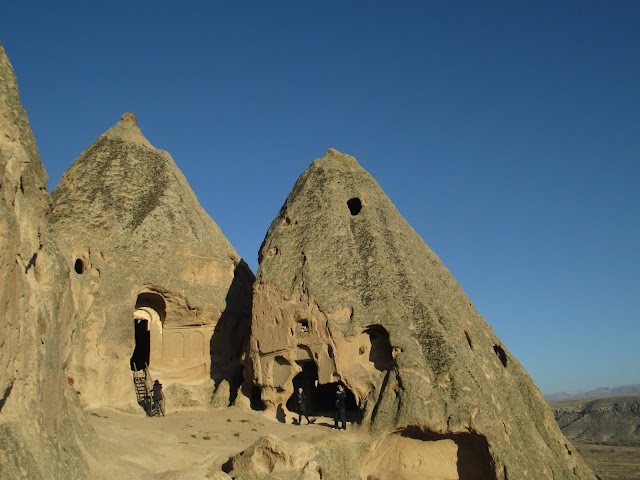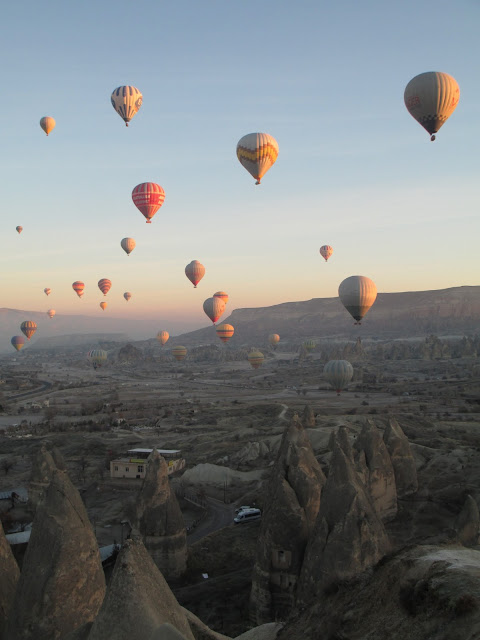Since we didn't arrive until 1 pm, we decided to undertake the half-day excursion of hiking the Rose Valley. It was within walking distance from our hostel, and the hike took us only about 3-4 hours total. But oh, the things we saw!
It was like being on another planet! The rock formations made such cool patterns, and the hot air balloons and the moon floating over them made the landscape even more ethereal.
Cooler still were the occasional reminders that people had made homes and churches here! The soft rock, made from volcanic ash, allowed people to easily carve it out.
On the last ridge, we sat and chilled a little while, just taking in the breathtaking scenery.
On the far side, we bought fresh-squeezed pomegranate juice and mulled wine from a mute man who ran a souvenir stand, and walked home along the road.
When we got back into town, we went to the aptly named and interestingly themed "Goreme Restaurant" for Christmas dinner.
 |
| Appetizers of hummus, olives, and DELICIOUS Turkish bread. |
 |
| My dinner... some kind of Turkish ravioli |
 |
| I couldn't have eggnog on Christmas night, but salep filled the void quite nicely. |
Ever since having read The World Without Us (which, by the way, is a great book), I had wanted to see the Derinkyu cave city in Turkey.
.jpg) |
| Photo credit: Wikipedia |
PRETTY COOL HUH!?
I thought so. So this was my single request upon visiting Cappadocia: we had to go to Derinkuyu. And the Green Tour would take us to Derinkuyu, as well as to a lot of other cool sites in the region.
The Green Tour started at a beautiful overlook of the valley, where our tour guide described the processes of erosion which had created the unique rock formations.
 |
| You can see in the background the snowy peak of one of the volcanoes which produced the ash mentioned above. |

Harder rock on top of soft rock meant that when cracks developed, the soft rock underneath wore away faster, resulting in "fairy chimneys."
After the overlook, it was off to Derinkuyu!
 |
| Couldn't believe I actually made it here! |
 |
| The cross etched above this doorway indicates that it's a holy place. |
 |
| Some of the hallways were quite wide. |
 |
| A seminary school with long benches for students/ |
There were some cave churches here, too.
Some of the paintings in this one could still be seen.
Then we hiked to the end of the valley, a pleasant place alongside a picturesque stream.
There were also pistachio trees. Did you know pistachios grew on trees?
Cave dwellings could also be seen here.
Look familiar?
That's probably because this place inspired George Lucas in creating the sand people's home in Star Wars. He wanted to film here, but the Turkish government wouldn't let him, so he had the scene reconstructed in Morocco.
This place was HUGE. Churches, cells, classrooms, kitchens... the tour guide told us that if we wanted to see the whole thing, it would take ten days to explore.
The view from the windows wasn't bad either.
 |
| The big tomb belonged to the wife of a sultan, whose name was Selime. Hence, the name of the monastery. |
When we got back to Goreme, we went out for a certain type of kebab which is cooked in a sealed clay pot-- you have to break the pot open to eat it.
 |
| Bread, butter and hummus for appetizers! |
 |
| Breaking open my pot with, what else?, a sword. |
 |
| The stew still boiling inside! Served with a side of rice and potatoes fried together. Yum! |
Disclaimer: I am not responsible for any symptoms which may arise from the intense beauty and/or whimsy of my photographs.
After a little nap, we went on to the Goreme Open Air Museum, which houses a bunch more amazing cave churches. I don't have many pictures because photography was prohibited in most of these places, but I can say that my favorite was the very last church in the place, called The Dark Church. The murals in this church were almost perfectly preserved, vibrant as if they had been painted yesterday. Beautiful byzantine-style iconography, biblical scenes, and labels of saints and angels in Greek which I could pretty well read because of its similarity to Cyrillic. Emily and I spent almost a half hour in this church just geeking out over it. The interior was so beautifully carved and painted that you forgot you were in a cave... it literally looked just like a modern church.
In the afternoon, we walked to the Love Valley. Not as picturesque as the other valleys... mostly popular because of its inappropriately-shaped rock formations.
Then in the evening, we took a flight back to Istanbul. We got lost on our way to the hostel and by the time we got in it was after midnight. We got only a few hours of sleep, as our flight to Kyiv was early the next morning.
But all in all, the trip to Turkey was well worth it! We crammed so much into that week, and really made it count. Still, there is so much to see in Turkey that I must go back someday. Not least of all, I really want to see Pamukkale and Ephesus. Hope you can join me in my future visits :)
























































seems like u loved baloons :D, www.theephesus.com
ReplyDelete